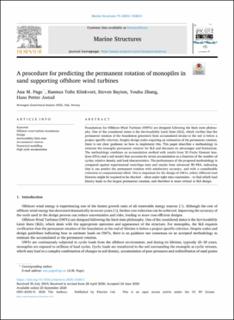| dc.contributor.author | Page, Ana M. | |
| dc.contributor.author | Klinkvort, Rasmus Tofte | |
| dc.contributor.author | Bayton, Steven | |
| dc.contributor.author | Zhang, Youhu | |
| dc.contributor.author | Jostad, Hans Petter | |
| dc.date.accessioned | 2020-10-07T20:08:14Z | |
| dc.date.available | 2020-10-07T20:08:14Z | |
| dc.date.created | 2020-10-07T14:21:59Z | |
| dc.date.issued | 2020 | |
| dc.identifier.citation | Marine Structures. 2020, 75 . | |
| dc.identifier.issn | 0951-8339 | |
| dc.identifier.uri | https://hdl.handle.net/11250/2681646 | |
| dc.description.abstract | Foundations for Offshore Wind Turbines (OWTs) are designed following the limit state philosophy. One of the considered states is the Serviceability Limit State (SLS), which verifies that the permanent rotation of the foundation generated from accumulated strains in the soil is below a project specific criterion. Despite design codes requiring an estimation of the permanent rotation, there is not clear guidance on how to implement this. This paper describes a methodology to estimate the monopile permanent rotation for SLS and discusses its advantages and limitations. The methodology combines an accumulation method with results from 3D Finite Element Analyses (FEA) and a soil model that accounts for strain accumulation as a function of the number of cycles, relative density and load characteristics. The performance of the proposed methodology is compared against experimental centrifuge tests and results from advanced 3D FEA, indicating that it can predict the permanent rotation with satisfactory accuracy, and with a considerable reduction in computational effort. This is important for the design of OWTs, where different load histories might be required to be checked – often under tight time constraints – to find which load history leads to the largest permanent rotation, and therefore is more critical to SLS design. | |
| dc.language.iso | eng | |
| dc.title | A procedure for predicting the permanent rotation of monopiles in sand supporting offshore wind turbines | |
| dc.type | Peer reviewed | |
| dc.type | Journal article | |
| dc.description.version | publishedVersion | |
| dc.source.pagenumber | 17 | |
| dc.source.volume | 75 | |
| dc.source.journal | Marine Structures | |
| dc.identifier.doi | 10.1016/j.marstruc.2020.102813 | |
| dc.identifier.cristin | 1837959 | |
| dc.relation.project | Norges forskningsråd: 268182 | |
| cristin.ispublished | true | |
| cristin.fulltext | original | |
| cristin.qualitycode | 2 | |
